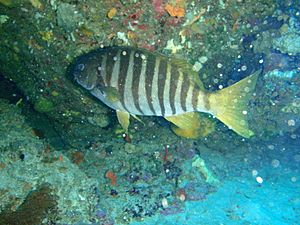Girella zebra facts for kids
Quick facts for kids Girella zebra |
|
|---|---|
 |
|
| Scientific classification | |
| Synonyms | |
|
The Zebrafish, also called the Stripey Bream, is a type of ray-finned fish that lives in the ocean. Its scientific name is Girella zebra. It belongs to a family of fish called Kyphosidae, also known as sea chubs. This fish is special because it only lives in the coastal waters of southern Australia, which is part of the Indo-Pacific region.
Contents
What the Zebrafish Looks Like
The Girella zebra has a body that is a bit short and deep. It is also flattened from side to side, like a pancake, and has an oval shape. Its tail section, called the caudal peduncle, is quite thin.
This fish has a small head with a forehead that sticks out a little. Its eyes are small too. The mouth is tiny and does not reach the front of its eye. The upper jaw bones, called maxilla, are hidden under the bones in front of its eyes.
The zebrafish has two rows of teeth on each jaw. The outer teeth are flat and have three points, like a tiny trident. They do not overlap. The inner row has many tiny teeth that are similar in shape to the outer ones.
Most of the fish's body is covered in small, rough scales called ctenoid scales. It has a special line along its side, called the lateral line, which helps it sense movement in the water. This line has 72 to 80 scales and curves along with the fish's back.
Fins
The dorsal fin (on its back) is one long fin. The spiny part of this fin has 14 spines and is about one-third longer than the soft part. The soft part has 13 to 15 soft rays. The longest spines are in the middle of the fin and are a bit longer than the longest rays.
The anal fin (on its belly, near the tail) is similar in length and shape to the soft part of the dorsal fin. It sits directly opposite the dorsal fin. The anal fin has three spines and 11 soft rays.
The large caudal fin (tail fin) is deeply forked, like a swallow's tail. The pectoral fins (on its sides, like arms) and pelvic fins (on its belly, like legs) are small. The top rays of the pectoral fin are the longest.
Color and Size
Adult zebrafish have a pale body with nine or ten dark stripes on their sides. These stripes get narrower towards the belly. Their fins are pale yellow. Young zebrafish are darker and their stripes are not as clear. Sometimes, they can be mistaken for another fish called a luderick. The G. zebra can grow up to 34 centimetres (13 in) long.
Where the Zebrafish Lives
The Girella zebra is found in the Indian Ocean and the western Pacific Ocean. It only lives in southern Australia. You can find it from the Clarence River in New South Wales, all the way south to Tasmania. It also lives along the entire southern Australian coast and up the western coast of Western Australia as far north as Port Denison.
Habitat and Life Habits
The Girella zebra usually lives around rocky reefs in shallow coastal waters. It can be found from the surface down to about 20 metres (66 ft) deep. You might also see it in calm waters offshore or in river mouths (estuaries).
What the Zebrafish Eats
The flat teeth and long, narrow gill rakers of the zebrafish help it eat small food items. It mostly eats seaweeds, so it is mainly a plant-eater (herbivore). However, it also eats small animals that live on the seafloor, like sea squirts. This fish often swims together in groups, which is called schooling.
Parasites of the Zebrafish
Scientists recently found a new type of tiny flatworm that lives inside the Girella zebra. These flatworms, named Pholeohedra overstreeti, are parasites. This means they live inside another animal and get their food from it. Scientists discovered them by carefully looking inside the intestines of the Girella zebra.
About the Zebrafish Family
There are 18 different types of fish in the Girella group, or genus. Some other well-known ones include Girella cyanea and Girella elevata.
The G. zebra belongs to the Kyphosidae family, which is a group of ocean fish known as sea chubs. Many fish in this family eat large seaweeds on coral reefs. Sea chubs are found all over the Atlantic Ocean, Pacific Ocean, and Indian Ocean. The Kyphosidae family has about 42 species, divided into two smaller groups: Kyphosinae and Girellinae.
How the Zebrafish Got its Name
The Girella zebra was first officially described in 1846 by a Scottish naval surgeon and naturalist named Sir John Richardson. He named it Crenidens zebra in his book about the fish he found on the voyage of the H. M. S. Erebus & Terror.
Zebrafish Hybrids
The Girella zebra is not very common in New South Wales and eastern Victoria. In these areas, it sometimes mates with another fish called G. elevata, creating a mix of the two species, which is called a hybrid.

